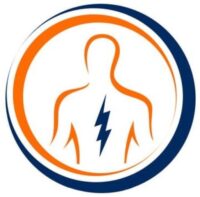Congenital Torticollis means that a baby is born with an odd position of the neck. Torticollis consists of two Latin words: tortis (twisted) & Collis (neck or collar).
Congenital Torticollis is a condition where there is a contracture of the sternocleidomastoid (SCM). Due to this contracture, the head tilt towards the affected muscle, and the chin points away from the contracted muscle.
Other names for congenital torticollis are ‘twist neck’ or ‘wry neck’.
Features of Congenital Torticollis:
- The tumor is palpable at birth or during the first two weeks of life.
- Common on the right side.
- May include the muscle diffusely but more often it is present near the clavicular attachment of the muscle.
- It attains maximum size within 1 to 2 months; usually, it disappears within a year.
- If it fails to disappear, then the muscle becomes permanently fibrotic and contracted and causing torticollis.
Causes of Congenital Torticollis:
- The supply to the middle part of the SCM is by an end artery, which is a branch of the superior thyroid artery that can get blockage due to trauma.
- Birth trauma– Breech presentation, improper application of forceps, etc. may also cause injury to the SCM.
The above two reasons can result in SCM muscle ischemia, necrosis, and fibrosis later on.
Clinical Features of Congenital Torticollis:
The deformity is the only initial complaint. Later there may be facial changes and macular problems in the retina.
PRIMARY DEFORMITIES:
- The tilt of the head to the same side.
- Taut sternocleidomastoid muscle.
SECONDARY DEFORMITIES:
- Distortion of facial expressions.
- Macular changes in the retina.
Treatment of Congenital Torticollis:
PRINCIPLES OF TREATMENT
- During infancy, conservative treatment consists of stretching the sternocleidomastoid by manipulation and physiotherapy.
- There can be a delay in surgery until there is well-formed fibroma. There may be the release of the muscle at one or both ends. Excision of the whole muscle can also be there.
- If the muscle is still in a contraction state at the age of 1 year, its release is essential.
- If the wry neck is persistent for 1 year, it will not resolve spontaneously & needs to interfere with operatively.
- The exercise program is successful:
- 1. When the restriction of motion is less than 30 degrees.
- 2. When there is no facial asymmetry.
- Non-operative treatment after 1 year is rarely successful.
- Any permanent torticollis becomes worse during growth. The inclination of the head towards the affected side, the turning of the face towards the opposite side, elevation of the ipsilateral shoulder, and increase in the frontoccipital diameter.
Physiotherapy Treatment:
The physiotherapy treatment in infancy for mild deformities proceeds on the following lines:
MEASURES AIMED AT PASSIVE CORRECTION
This actually is the mainstay of treatment in early cases of torticollis in infancy. The steps are as follows:
- Assess the extent of deformity and the existing range of motion (ROM).
- To relax the muscles, suitable thermotherapy and gentle massage are helpful.
- All the movements of the neck carry out passively by bringing the head of the child beyond the edge of the table in a supine position. With an assistant stabilizing both the elbows and with a pillow beneath the chest, all the neck movements are carried out in a gentle relaxed manner passively.
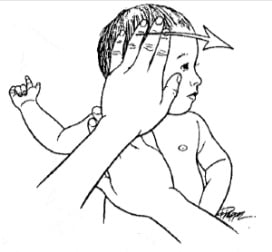
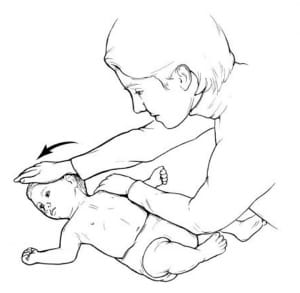
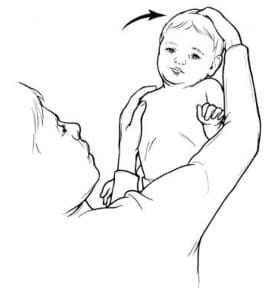
- After the above steps, a gentle sustained passive stretch is carried out in the opposite direction of the affected muscle and held for some time in that direction.
- After doing the above steps, there will be the maintenance of the passive correction by supporting the neck with appropriate pillows or supports.
ACTIVE MEASURES
This is a little difficult since the child is still in its infancy and cannot carry out the oral commands. By using a bright object which makes noise, the attention of the child can be drawn and its head can be made to move in the arc of correction.
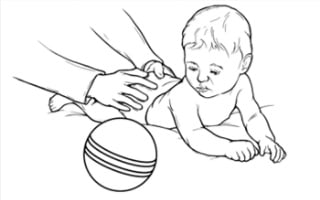
HOME TREATMENT REGIMEN
Since the above methods need repetitions, the mother of the child is taught to carry them out at home.
Other than the above methods, two additional measures that the mother needs to carry out are as follows:
- In the prone position, with the head of the child turned towards the opposite side, the child is encouraged to look back over the shoulder in the opposite direction.
- During sleep, the head of the child is positioned by pillow support on the opposite side of the deformity. This simultaneously relaxes and maintains the neck in the corrected position.
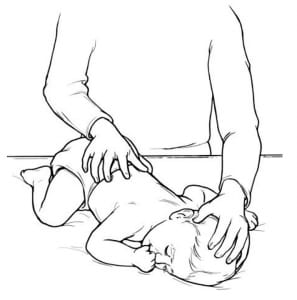
Surgical Methods:
The most common surgical method is subcutaneous tenotomy of the clavicular attachment of the SCM muscle.
For older children or after a failed operation, the bipolar release of the muscle from both sides, Ferkel’s modified bipolar release or Z-plasty of the muscle is tried.
Physiotherapy after surgery
- MEASURES TO CONTROL PAIN: By thermotherapy, hydrotherapy, etc.
- EXERCISES: Active ROM exercises for the SCM muscle.
- SUPPORTIVE DEVICES: Like the cervical collar till the achievement of adequate correction.
Conclusion:
Congenital torticollis is a condition in which there is a contracture of the sternocleidomastoid muscle. Today, in the above article, we discussed the clinical features, causes, and treatment of torticollis. We also discussed the physiotherapy management of congenital torticollis.
ALL THE BEST!
